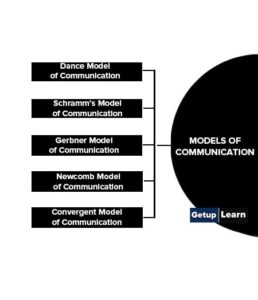Table of Contents
- 1 What is Communication Network?
- 2 Types of Communication Network
- 3 Flow of Communication in an Organization
-
4 FAQ Related to Communication Network
- 4.1 What are the 5 types of communication networks?
- 4.2 What is flow of communication in an organization?
- 4.3 What is vertical network communication?
- 4.4 What is circuit network communication?
- 4.5 What is chain network communication?
- 4.6 What is wheel network communication?
- 4.7 What is star network communication?
What is Communication Network?
A communication network is a group of methods that users employ to pass on valuable information. The communication network is the sum of all the means and methods that an organization employs to communicate.
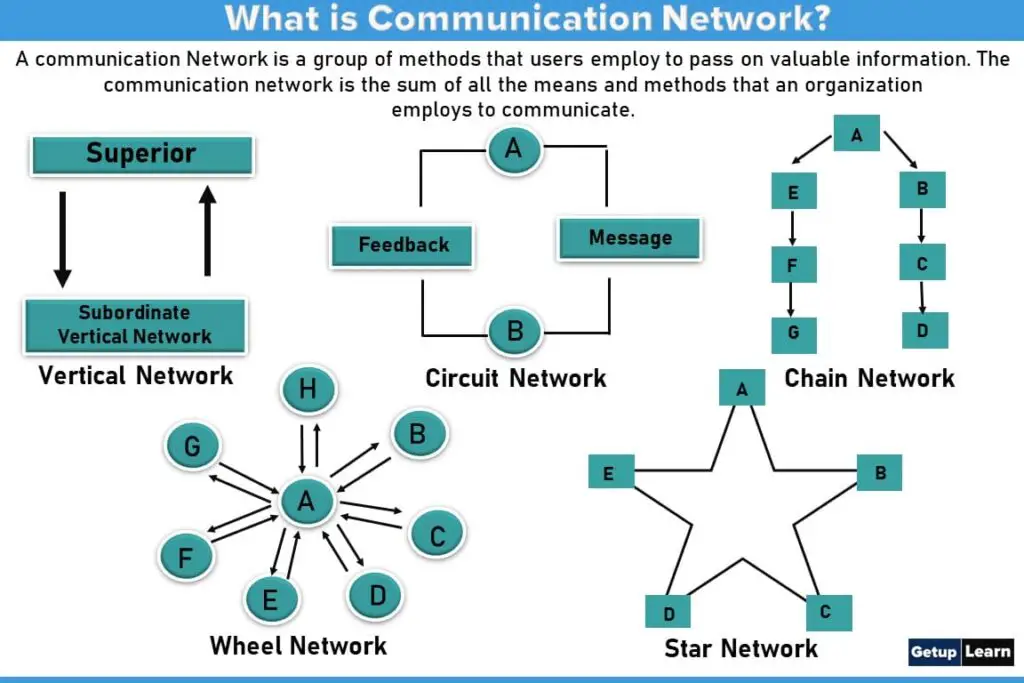
According to Newman and Summer Communication is an exchange of ideas, facts, opinions or emotions by two or more persons. The specific communication undertaken by the business firm is known as business communication. In short, we can define business communication as a process in which two or more elements of a system interact in order to achieve a desired outcome or goal.
Organizational members connect into various groups and as members of the group, they interact with each other in a specific manner. The path along which they interact is called the communication network.
It is a type of pattern in which information flows between the members of the group for the entrepreneur, the art of communication is a key to informing, inspiring, and engaging in the nature of employees.
and customers. Communication is where change begins. Culture is where movements are born. When you focus solely on the how-to, of communication and neglect the foundation you miss an opportunity to create a culture of communication.
Another important aspect of a communication network is that it also indicates the form of single-channel and multiple channels of communication to regulate the flow of information and ensure that information reaches the desired destination. It indicates the times through which information flows between peoples.
Types of Communication Network
These are the types of communication networks given below:
- Vertical Network Communication
- Circuit Network Communication
- Chain Network Communication
- Wheel Network Communication
- Star Network Communication

Vertical Network Communication
The vertical network is usually between the superior and subordinate and vice versa. It is two-way communication, the immediate feedback is possible in this type of communication network. It is a formal network.
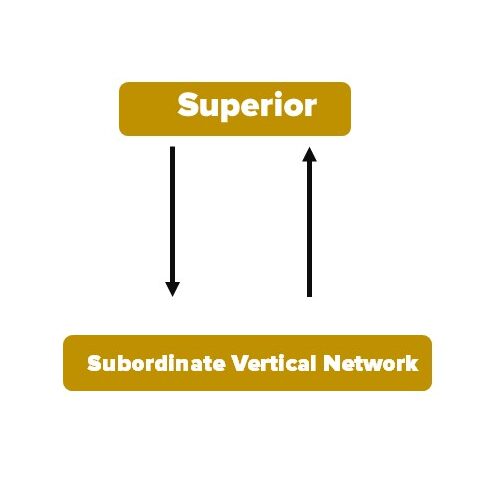
Circuit Network Communication
Under this network, two persons communicate with each other. Say Mr. ‘A’ sends a message to Mr. ‘B’, and communicates the feedback message to Mr. ‘A’ so communication takes the form of a circuit. Therefore it is known as a circuit network. It is similar to a vertical network but in a circuit network, ‘A’ and ‘B’ are not necessarily superior and subordinate.
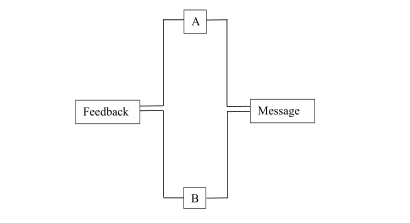
Chain Network Communication
This network follows the organizational hierarchy and chain of command. All subordinates receive commands or instructions from their superiors. B, C, D, and E, F, and G are the subordinates to A in the organizational hierarchy and receive a command from ‘A’ which follows the way shown in the diagram.
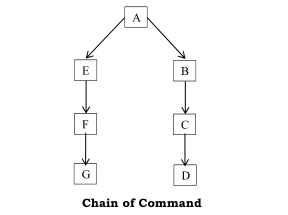
Wheel Network Communication
Here all the subordinates receive commands from one superior. This is the highly centralized type of communication, the network where each subordinate receives commands or instructions from a single authority or superior ‘A’ and wants immediate feedback.
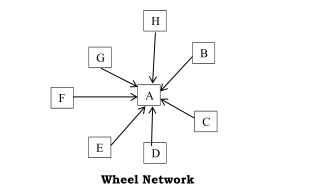
Star Network Communication
Under the star Communication network, all members of the group communicate with each other and exchange information. This network is a must for group communication or where teamwork is involved. Here the members communicate with each other without hesitation.
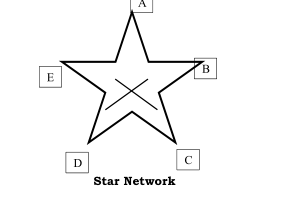
Flow of Communication in an Organization
The effectiveness of the above networks of communication channels depends on their users the managers at all levels, their subordinates and other members of the organization, and above all the seriousness with which all these human resources make use of the facilities provided to them by the organization to accomplish its objective.
Following is the flow of communication in an organization:
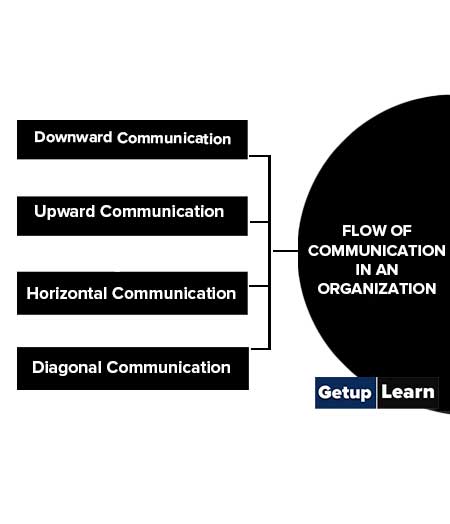
Downward Communication
As it is clear by its name, in downward communication information flows from the top officials. The information may be an instruction, appraisal, or announcement. Both oral and written media are used for downward communication.
The main means of downward communication are memos, notices, circulars, jobs sheets, and employees‘ handbooks. Generally, downward communication is used by top-level managers to convey their strategies. Objectives, instructions, policies, etc. to their sub-ordinates. It is also known as downstream communication. As a result of it, employees working in the firm get more strengthened and encouraged. The main elements of downward communication have been depicted here.
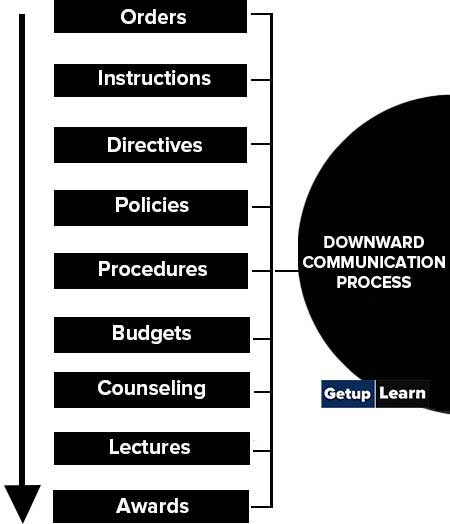
Upward Communication
Upward communication is just the opposite of downward communication. In it, a piece of information flows from the subordinates to the top management with the help of an open door policy, complaint and suggestion boxes, direct contacts, reports, etc. The top management itself organizes special programs to know the ideas and problems of the sub-ordinates.

Horizontal Communication
A horizontal communication takes place among the various persons and departments working at an equal level in the organization. It is also known as lateral communication. Downward and upward communication is known as vertical communication.
It can be made through both spoken as well as written words. Immediate feedback is received under it and clarifications are made on the spot. Horizontal communication is necessary for the smooth functioning of firms.

Diagonal Communication
Diagonal communication is a communication in which employees interact with each other i.e. lower level employees communicate with higher-level employees beyond their hierarchical status. It is also known as cross-wise communication.
Advantages of Diagonal Communication
Following are the advantages of diagonal communication:
-
Promotes coordination: Diagonal communication promotes coordination among different persons and departments of the organization. Hence, it results in smooth functioning.
- Boosts Morale: Diagonal communication boosts the morale of different employees and executives by providing them the opportunity to interact with each other and also to solve their problems.
Disadvantages of Diagonal Communication
Following are the disadvantages of diagonal communication:
- There are chances of spreading rumors in this communication can result in the spreading of rumors. Therefore this communication is not reliable and long-lasting.
- Creates conflicts: In Diagonal communication, one can make contact with superiors of the departments by passing all middle levels. As a result, there are chances of conflicts among superiors of different departments.
Read More Related Articles
[su_spoiler title=”What is Communication? | Mass Communication” style=”fancy” icon=”plus-circle”]
What is Communication?
[/su_spoiler]
[su_spoiler title=”Types of Communication | Principles of Communication” style=”fancy” icon=”plus-circle”]
Types of Communication
-
Types of Communication
- Verbal Communication
- Non-Verbal Communication
- Written Communication
- Visual Communication
- Feedback Communication
- Mass Communication
- Group Communication
[/su_spoiler]
[su_spoiler title=”Nonverbal Communication | Verbal Communication” style=”fancy” icon=”plus-circle”]
[/su_spoiler]
[su_spoiler title=”Written Communication | Oral Communication” style=”fancy” icon=”plus-circle”]
Written Communication
[/su_spoiler]
[su_spoiler title=”Business Communication | Organizational Communication” style=”fancy” icon=”plus-circle”]
Business Communication
[/su_spoiler]
[su_spoiler title=”Formal Communication | Informal Communication” style=”fancy” icon=”plus-circle”]
[/su_spoiler]
[su_spoiler title=”Interpersonal Communication | Informal Communication” style=”fancy” icon=”plus-circle”]
[/su_spoiler]
[su_spoiler title=”Downward Communication | Upward Communication” style=”fancy” icon=”plus-circle”]
Downward Communication
[/su_spoiler]
[su_spoiler title=”Barriers to Communication | Horizontal or Lateral Communication” style=”fancy” icon=”plus-circle”]
[/su_spoiler]
[su_spoiler title=”Self Development | Effective Communication” style=”fancy” icon=”plus-circle”]
[/su_spoiler]
[su_spoiler title=”Difference Between Oral and Written Communication | Theories of Communication” style=”fancy” icon=”plus-circle”]
[/su_spoiler]
What are the 5 types of communication networks?
These are the 5 types of communication networks:
1. Vertical Network
2. Circuit Network
3. Chain Network
4. Wheel Network
5. Star Network.
What is flow of communication in an organization?
Communication in an organization can involve different types of employees and functional parts of an organization. These are patterns of communication are called flows, and the Following is the flow of communication in an organization: downward, upward, horizontal, diagonal, or external.
What is vertical network communication?
The vertical network communication is usually between the superior and subordinate and vice versa. It is two-way communication, the immediate feedback is possible in this type of communication network. It is a formal network.
What is circuit network communication?
Under circuit network communication, two persons communicate with each other. Say Mr. ‘A’ sends a message to Mr. ‘B’, and communicates the feedback message to Mr. ‘A’ so communication takes the form of a circuit. Therefore it is known as a circuit network. It is similar to a vertical network but in a circuit network, ‘A’ and ‘B’ are not necessarily superior and subordinate.
What is chain network communication?
chain network communication follows the organizational hierarchy and chain of command. All subordinates receive commands or instructions from their superiors. B, C, D, and E, F, and G are the subordinates to A in the organizational hierarchy and receive a command from ‘A’.
What is wheel network communication?
Here all the subordinates receive commands from one superior. This is the highly centralized type of communication, the network where each subordinate receives commands or instructions from a single authority or superior ‘A’ and wants immediate feedback.
What is star network communication?
Star Communication network, all members of the group communicate with each other and exchange information. This network is a must for group communication or where teamwork is involved. Here the members communicate with each other without hesitation.

